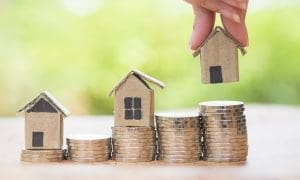The Fannie Mae home loan program has been one of the most successful programs helping consumers in the United States buy a home with a minimal down-payment with competitive interest rates equating to affordable monthly payments. is government sponsored enterprise that has played a major role in empowering Americans to become home-owners.
Becoming a homeowner has long been a considered a medal symbolizing the American dream. Owning a house is a financial investment and a great way to create wealth in a democratic country. While many factors contribute to getting approved for a Fannie Mae home loan, one crucial element that has played a significant role in making it accessible to millions of Americans is Fannie Mae.
Fannie Mae, or the Federal National Mortgage Association, is a government-sponsored enterprise established in 1938 during the Great Depression. Its mission was, and still is, to provide stability, liquidity, and affordability to the U.S. housing market. Fannie Mae achieves this through a range of finance loan products, the most well-known of which are Fannie Mae home loans.
Fannie Mae Home Financing
Fannie Mae operates as a secondary mortgage market institution. In essence, it purchases home mortgages from primary lenders like banks and credit unions, providing these lenders with capital to continue originating purchase money mortgages. This process, known as securitization, allows banks and lenders to recycle their funds, ensuring a constant flow of mortgage financing.
The key innovation that Fannie Mae brought to the housing market was the creation of mortgage-backed securities (MBS). Instead of holding individual mortgages on its balance sheet, Fannie Mae bundles these loans into MBS and sells them to investors. This practice not only frees up capital for mortgage lenders but also spreads the risk of default across a broader pool of investors.
What Types of Loans Does Fannie Mae Offer
Fannie Mae offers various mortgage programs to cater to the diverse needs of American homebuyers. Here are some of the most prominent types of Fannie Mae home loans:
- Conventional Loans: These are the most common type of Fannie Mae loans and often referred to as conforming loans. They adhere to specific lending limits set by the Federal Housing Finance Agency (FHFA) and typically require a down payment of at least 3%.
- HomeReady Loans: This program was created to promote homeownership in low- to moderate-income communities, HomeReady loans offer lower down payment requirements, flexible eligibility criteria and reduced private mortgage insurance (PMI) costs. Learn more about HomeReady program.
- HomeStyle Loans: The HomeStyle loan program is great for those looking to purchase a fixer-upper or make significant renovations to their existing home. They provide capital for both the purchase price and the renovation costs, all within a single mortgage. Learn more about Fannie Mae HomePath.
- Refinance Mortgages: Many do not realize that Fannie Mae provides home refinancing options, such as the High LTV Refinance Option (HIRO) and the RefiNow program, targeting homeowners that seek to lower their monthly mortgage payments or access cash through a refinancing transaction.
- DUO (Down Payment Option): The DUO program allows for flexible down payment options, as minimal as 3% down. This makes buying a home more attainable for most people.
The Impact on Homebuyers
Fannie Mae loans have had a profound impact on the American housing market and its participants:
- Wider Access to Homeownership: By providing liquidity to lenders and lowering down payment requirements, Fannie Mae has enabled millions of Americans, who might otherwise have been excluded, to become homeowners.
- Lower Interest Rates: The liquidity Fannie Mae provides tends to keep mortgage interest rates lower. This makes homeownership more affordable and reduces the overall cost of borrowing for millions of families.
- Stability in the Market: Fannie Mae’s presence as a stabilizing force in the housing market played a vital role during economic downturns, such as the 2008 financial crisis. Its commitment to maintaining liquidity helped prevent a more catastrophic collapse of the housing market.
- Innovation in Mortgage Products: Fannie Mae continually introduces innovative mortgage products, like HomeReady and HomeStyle loans, which adapt to the evolving needs of borrowers and the housing market.

Challenges and Criticisms of Fannie Mae Loan Programs
Fannie Mae home loans have played a crucial role in expanding homeownership, it has not been without its share of challenges and criticisms. Some of the key concerns include:
- Risk to Taxpayers: As a GSE, Fannie Mae enjoys certain privileges, such as a government guarantee on its MBS. In the past, this led to significant taxpayer liabilities when the housing market experienced downturns.
- Too Big to Fail: Fannie Mae’s size and systemic importance in the housing market have led to debates about whether it should be allowed to continue its operations without significant reforms.
- Impact on Affordable Housing: Critics argue that Fannie Mae’s practices have contributed to rising home prices in some markets, making it harder for lower-income families to afford homes.
What Is the Future of Fannie Mae?
In recent years, Fannie Mae loans have undergone several changes and reforms. One significant development is the Conservatorship that began during the 2008 financial crisis when the federal government took control of Fannie Mae to prevent its collapse.
Moreover, the Federal government has had discussions about the role of Fannie Mae in the future housing finance system. Some members of Congress propose privatizing the entity entirely, while others argue for maintaining a government guarantee to ensure stability in the housing market with affordable Fannie Mae home loans.
Fannie Mae home loan programs have been instrumental in encouraging homeownership by making it more attainable for countless of Americans. FMNA has always been revered for innovative financial products and commitment to liquidity have helped stabilize the home financing market and promote the American dream of homeownership. However, challenges and debates about its future persist, making the future of Fannie Mae an important topic in the realm of housing finance and policy.
